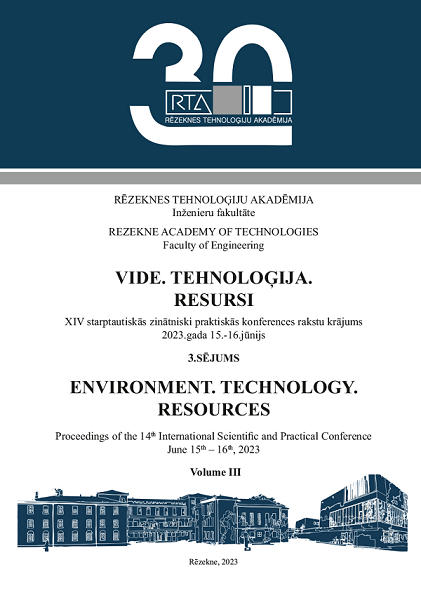OPTICAL SYSTEMS FOR REDUCING THE DIVERGENCE OF LASER BEAMS
DOI:
https://doi.org/10.17770/etr2023vol3.7217Keywords:
beam divergence, beam expander, laser, optical designAbstract
The rational use of lasers as sources of radiation is also related to the development of optical systems for conversion of laser radiation. One of the ways to convert the laser radiation is related to its collimation, changing the cross-section and changing the divergence. This article presents a methodology for designing two component optical systems to reduce the divergence of laser beams. Ready-made optical elements were used, with which three different configurations were created and analyzed. The optical design was developed and subsequent optimization was performed. The resulting system has diffraction-limited quality of the outgoing laser beam and small dimensions.
References
H.J. Eichler, J. Eichler and O. Lux, Lasers: Basics, Advances and Applications, Springer Series in Optical Sciences, Springer Nature Switzerland AG, 2018.
V. Neumann, “Focusing and optical imaging in applied laser technologies”, Laser Technik Journal, Vol.9, Issue 1, Jan.2012, pp. 41-44, doi: 10.1002/latj.201290007.
I. Kolev and T. Karadzhov, “Classification, parameters, characteristics and application of matrix semiconductor photoconverters”, 27th International Spring Seminar on Electronics Technology, ISSE 2004, Bankya 13-16 May 2004,Vol. 3, pp. 444 – 447, doi:10.1109/ISSE.2004.1490852.
L. H. J. F. Beckmann and D. Ehrlichmann, “Optical systems for high-power laser applications: principles and design aspects”, Optical and Quantum Electronics, Vol. 27, Issue 12, pp. 1407 – 1425, Dec. 1995, doi: 10.1007/BF00326492.
F. Bisti, I. Alexeev, M. Lanzetta and M. Schmidt, “A simple laser beam characterization apparatus based on imaging”, Journal of Applied Research and Technology, Open Access, Vol. 19, Issue 2, Pages 98 – 116, April 2021, doi: 10.22201/icat.24486736e.2021.19.2.157.
D. Dichev, F. Kogia, H. Koev and D. Diakov, “Method of Analysis and correction of the Error from Nonlinearity of the Measurement Instruments”, Journal of Engineering Science and Technology Review, Vol. 9, Issue 6, 2016, pp. 116-121, doi: 10.25103/jestr.096.17.
P.A. Nosov, V.Yu. Pavlov, I.I. Pakhomov and A.F. Shirankov. Aberrational synthesis of optical systems intended for the conversion of laser beams. J Opt Techn 2011; 78(9): 586- 593. doi: 10.1364/JOT.78.000586
B. Eppich, “Optical Design of Beam Delivery and Beam Forming Systems.”, Optik & Photonik, Vol. 3, Issue 2, pp. 48-51, June 2008, doi: 10.1002/opph.201190193.
F. Abt, A. Heß and F.Dausinger, “Focusing of high power single mode laser beams”, 26th International Congress on Applications of Lasers and Electro-Optics, ICALEO 2007 - - Congress Proceedings, doi: 10.2351/1.5061053.
S.A. Self, “Focusing of spherical gaussian beams”, Applied Optics, Vol. 22, Issue 5, pp. 658 – 661, March 1983, doi: 10.1364/AO.22.000658.
T. Wang, C. Cao, X. Zeng, Y. Liu and J. Ning, “Analysis of divergence angles of truncated and untruncated beams in collimation system”, Optik, Vol. 194, Oct. 2019, doi: 10.1016/j.ijleo.2019.163130.
X. Liu, J. He, X. Sun and M. Zhang, “Instrument for collimating and expanding Gaussian beams for underwater laser imaging systems”, Optical Engineering, Vol. 37, Issue 9, pp. 2467 – 2471, Sept. 1998, doi: 10.1117/1.601770.
L. Lévesque, “Divergence of far-infrared laser beam and collimation for Galilean and Keplerian system designs”, Optics and Laser Technology, Vol. 41, Issue 5, pp. 557 – 561, July 2009, doi: 10.1016/j.optlastec.2008.10.009.
R. S. Sirohi, “Optical beam collimation procedures and collimation testing: A summary”, Optical Engineering, Vol. 59, Issue 4, April 2020, doi: 10.1117/1.OE.59.4.040801.
D. Shafer, "Two-element laser beam expander", Optics and Laser Technology, Vol. 14, Issue 1, Pages 37–38, Febr.1982, doi: 10.1016/0030-3992(82)90066-4.
A.F. Shirankov, P.A. Nosov, I.I. Pakhomov, A.G. Grigor'yants, V.P. Yakunin and R.S. Tret'yakov, Elaboration of laser optical systems of technological installations on the base of the laser optics theory. Inzhenernyy zhurnal: nauka i innovatsii [Engineering Journal: Science and Innovation], no. 9 (21), 2013, doi: 10.18698/2308-6033-2013-9-926
H. Sun, “Thin Lens Equation for a Real Laser Beam with Weak Lens Aperture Truncation”, Optical Engineering, Vol. 37, No. 11, 1998, pp. 2903-2913, doi: 10.1117/1.601877.
R. G. Schuhmann, "Standardized optical components for laser applications", Proceedings of SPIE - The International Society for Optical Engineering, Vol. 3737, pp. 644 - 648, Design and Engineering of Optical Systems II, August 1999, doi: 10.1117/12.360063.
R. G. Schuhmann, "Quality of optical components and systems for laser applications", Proceedings of SPIE - The International Society for Optical Engineering, Vol. 3578, pp. 672 - 680, Laser-Induced Damage in Optical Materials, April 1999, doi: 10.1117/12.344430.



